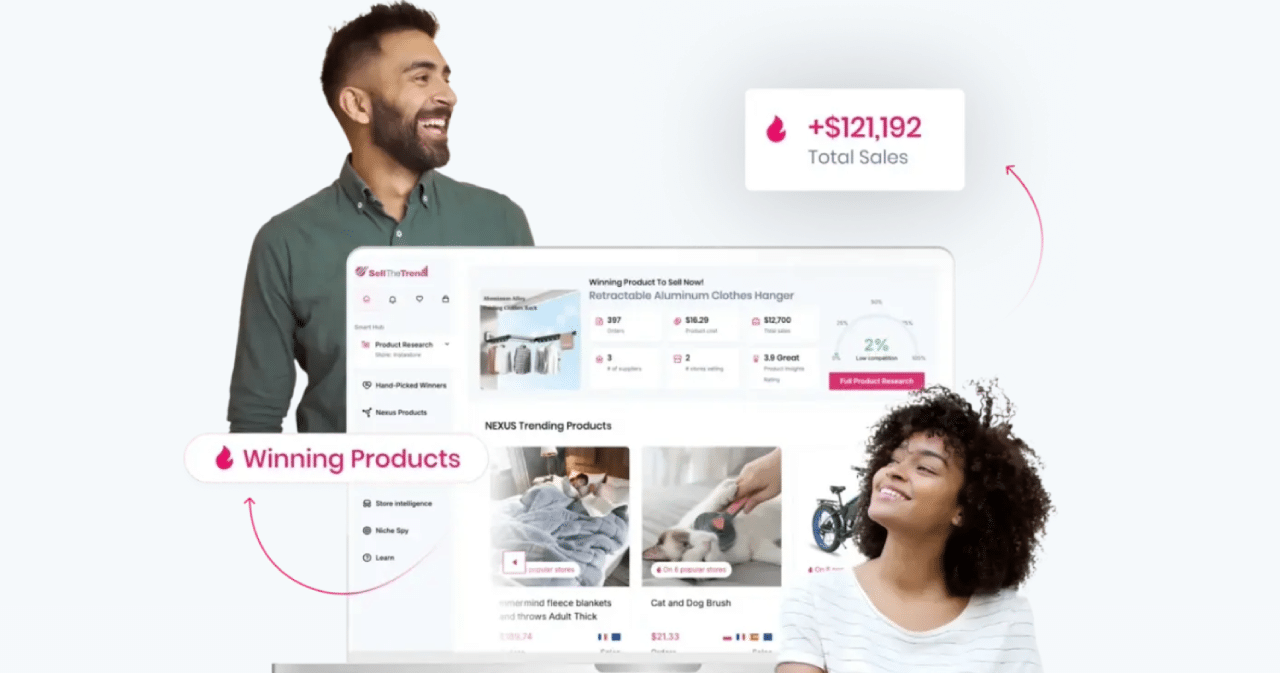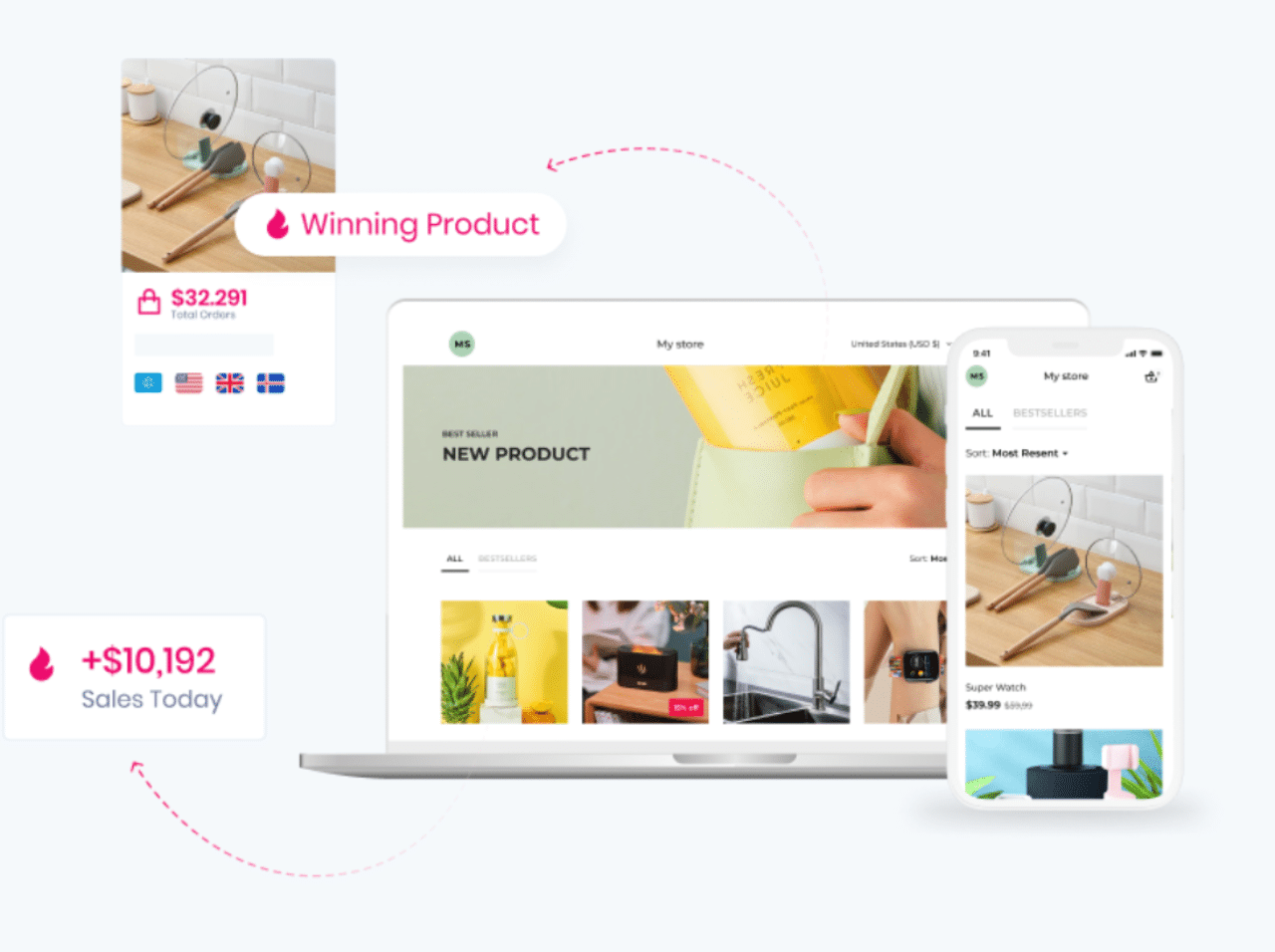“Product Research Process: How To Do It Effectively & Efficiently”
Contents
You keep launching products that come close but never hit the mark, and you are done with the guessing game.
So what happens now?
Use this guide to explore a product research process that clears the fog and shows you exactly where to focus. You can also walk through simple, proven best practices to connect with your target audience and cut through the noise.
By the end of your read, you will be ready to run a successful product research process that helps you sell winning products.
Crack The Code: A Clear Path To Winning Product Ideas
Gather your team and use these steps to check if your product ideas have strong potential before you move forward with development.
Step 1: Pinpoint The Why Behind Your Research
Get clear on what you want to learn and why it matters before you collect a single data point. Remember, you are doing market research to solve a specific problem or answer a key question.
Without a clear purpose, your product teams can chase data that feels helpful but does not drive decisions.
The result? You waste time, misread user insights, and miss real opportunities hiding in plain sight.
What To Do
Choose a specific market research goal. To do this, write down exactly what you want to learn, but make sure your goal is SMART. People who set SMART goals are 90% more likely to achieve them than those with vague goals, so it is worth taking the time to get clear.

For example, let’s say you are in the toy niche and thinking of adding these customizable playhouses to your product offers. Your SMART goal can be:
- In the next 10 days, let’s ask 100 parents of kids ages 3 to 8 to learn whether affordability or eco-friendliness matters more when choosing a customizable playhouse.
This goal gets clear on what you want to learn, which is what drives purchase decisions, and why it matters: It helps you build a product that solves the right problem for your future customers.
To further know the what and why behind your product research, look for gaps in similar or competing products. To do this, scan reviews, Q&A sections, and customer feedback on products that solve similar problems. Ask these:
- What frustrates people?
- What keeps popping up?
This shows you what is missing or broken in products people already use. When the same complaints keep showing up, you know there is a real problem worth solving, and that is your reason to dig deeper.
To get a head start, team up with an eCommerce consultant. They can help you dig into the right questions, connect them to real customer problems, and shape a purpose-driven research plan from day one.
Step 2: Shape Your Strategy With The Right Methodology
Choosing the right research methods is what turns curiosity into a clear direction. If you skip this or choose the wrong approach, you risk collecting surface-level insights.
Worse, you risk chasing answers to the wrong questions. The method you choose shapes how you collect data, how deep you go, and how confident you can be in your next move.
Here are the methods you can choose from:
- Qualitative research: Interviews, focus groups, and observations that provide a deeper understanding of user motivations.
- Quantitative research: Surveys, analytics, and market data that provide numerical insights.
What To Do
Clarify what you want to learn. Do you need numbers or context? This will help you decide between quantitative methods and qualitative data.
Next, consider your timeline and resources:
- Short on time? Use surveys.
- Want richer insight? Try focus groups or interviews.
You should match the method to the stage of your research, too. Early-stage ideas benefit from exploratory user research like interviews. Later stages need validation, like A/B tests.
Also, mix methods when needed. For example, let’s say you are in the home improvement space and you want to sell outdoor kitchen cabinets for next summer. You can combine surveys with in-person showroom observations to understand how customers interact with and evaluate cabinet materials and designs.
Lastly, stay flexible through product research. What works for one question might not work for the next. Adapt your approach as you go.
Step 3: Get Inside Your Users’ Minds
Get to know who your potential users are, what they care about, and why they might choose (or skip) your product. Use this step to listen before you build.
Also, this stops you from building for the wrong people. You do not just want a product with features, you want a user-centric solution that solves real pain points your target market feels.
What To Do
Run short, focused surveys. Keep it simple: 5–7 questions max. Ask about customer needs, frustrations, and what they currently use. Watch for patterns in the user responses.
Another option is to do interviews. Talk to 5–10 people who might use your product. Make sure to ask open-ended questions and listen for emotional buying triggers or repeated pain points.
You can also use heatmaps, screen recordings, or session replays to see how users behave on your product pages: what they click, scroll past, hesitate on, or ignore completely. These actions reveal what draws interest, what confuses them, and which features might need a second look.
To help you with this, use tools like Hotjar.

Also, to help you build these product pages for testing, team up with a front-end developer who can create clickable prototypes or simplified versions tailored for user behavior analysis.
Additionally, scan 3-star reviews. You will see what people like, what is missing, and where there is unmet market demand.
Finally, use your customer research to build simple, one-page snapshots of different users. For example, sketch out “Working Parent Paula,” who values quick setups and durability, or “Creative Kid Sam,” who wants fun features and personalization.
These mini profiles keep your product decisions grounded in real customer needs throughout product development. Use them to guide features, messaging, and design.
Step 4: Read The Room – What The Market’s Telling You
Step back and pay attention to the bigger picture:
- What is the market doing?
- Where is it headed?
- How does it affect your next move?
You go beyond just validating a product idea; you are spotting whether the timing, demand, and space make sense. For example, let’s say you are in the golf niche and you want to see if selling a lithium golf cart battery is the right next step.
Through product research, you spot growing interest in “longer-lasting golf batteries” and notice top competitors get repeated complaints about slow charging. That shows a clear gap in the market, so you can position your battery around speed, durability, and reliability to meet what golfers are actively looking for.
What To Do
Use product research tools like Sell The Trend. Maximize the NEXUS AI tool to dig into 26 data points per product and discover which niches are hot.

You should also check tools like Google Trends or trend-specific newsletters. Look for emerging trends that match your product idea before the curve, not after they become mainstream.
Another tactic is to study bestsellers on online marketplaces like Amazon and Etsy. Ask yourself: what are they doing right, and where is the gap?
Also, follow competitor moves. Track what they launch, discount, or promote heavily. These shifts offer clues about demand and what is no longer working.
You should also pay attention to demographic shifts that reveal untapped market opportunities. For example, seniors currently hold approximately 70% of the disposable income in the US, making them a powerful consumer segment, yet many digital marketers overlook them.
When researching potential products, think about how they could appeal to this financially influential demographic, especially in categories like health, comfort, travel, or leisure.
Step 5: See If Your Product Concept Holds Up In The Wild
So now that you are leaning toward moving forward with your initial product idea after doing the previous steps, it is time to pause and test it first.
What does this mean for you?
You need to run small, focused experiments to see if your idea resonates before you invest time, money, or energy building it out. Product managers who test early avoid wasted money, faster pivots, and build with confidence, not blind hope.
What To Do
Share a simple version of your idea with mockups, landing pages, or product cards, and ask real users:
- What they like
- What is unclear
- What is missing
You can also set up low-budget Facebook or Google ads to see how people respond. With this, you can learn fast which angles get attention and which flop, before you continue building.
Additionally, you can watch how users interact with your prototype. To do this, use tools like Lyssna to spot confusion, interest, or frustration early.

Try to also run A/B testing on product names, messaging, or features to see which version drives more engagement or interest.
Finally, test ideas with a waitlist or pre-sale. Launch a basic page and see who signs up. It is fast, cheap, and very telling.
Step 6: Execute, Learn, & Evolve
This is where everything you researched turns into action. But your thorough product research does not end at the product launch, it evolves with it. From messaging to quality assurance, this stage helps you fine-tune what you have already built based on real results.
What To Do
Start with a soft launch, limited drop, or beta release. Use this chance to test key product features in a controlled way and spot any surprises early.
After your launch, gather feedback through reviews, support tickets, direct messages, and surveys. Analyze it for patterns that can guide your next update.
You should also track responses to product features. Are they using what you expected? Are they ignoring what you thought was a standout? These clues help you prioritize future updates.
Regularly analyze market trends too to make sure your offer stays relevant and competitive even after launch. Lastly, use positive publicity to your advantage.
If a blog, influencer, or early user says something great, amplify it. Good word of mouth builds trust and gives your product momentum during and after your launch.
Make It Count: Best Practices For Product Research & Launch Success
Apply these tips to create a strong product research process, cut out what is not working, and launch your product with fewer risks and more confidence.
A. Host A “Build With Us” Community
Invite potential customers to be part of your journey and give them a voice as you shape your product. Done right, this gives you real-time insight throughout the product development process.
With this, you also cut down the guesswork, gather user feedback early, and avoid painful pivots post-launch. It is like doing market analysis in motion, powered by people who want you to succeed.
Here are ways to host a “Build With Us” community effectively:
- Use quick votes to let users weigh in on designs, names, or features
- Share behind-the-scenes updates. Let them see your sketches, prototypes, or packaging concepts to create buy-in.
- Start a private Facebook group or Slack channel and invite users who fit your ideal customer profile. Share updates, ask questions, and get fast, honest reactions.
- Offer perks for participation. Free products, discounts, or public recognition go a long way.
B. Create A Research Culture
Build a mindset across your team that values asking the right questions, running smart tests, and using data to guide every decision.
How does this help you?
A strong research culture helps you avoid building in a vacuum. When your team treats product research methods as standard practice, you make smarter decisions faster. They already know how to gather insights, question assumptions, and learn from data.
It also makes your competitive analysis sharper and your launch timing more strategic, since you and your team will see patterns early and often.

Here are ways to create a research culture that sticks:
- Host monthly “insight shares.” Ask one team member to present a quick takeaway from recent research.
- Create templates for product research methods to make it easy for anyone to start with ready-made templates for user interviews, surveys, or feedback collection.
- Run short research sprints. Dedicate a few days to deep dives before major product decisions.
- Set up a shared folder or Slack channel to drop key learnings from ongoing research.
- Encourage them to learn qualitative and quantitative methods. Give them resources or short training to understand the basics.
C. Make SEO Part Of Your Product DNA
Weave the basics of SEO into your product decisions, from naming and features to how you describe it online.
Why?
53.3% of all website traffic comes from organic search. When you treat SEO as an essential part of product development, you turn product discovery into a growth engine. It helps shape your marketing strategies, keeps your messaging clear, and saves time later by making your content searchable from the start.
Here are ways to make SEO part of your product DNA:
- Use SEO tools like Ahrefs to guide content strategy and shape blog ideas, landing pages, and FAQs.
- Understand link-building importance and plan outreach or PR around pages that support your SEO goals.
- Do keyword research before naming your product to find words people search for and see how they describe the problem your product solves.
- Add keywords to feature naming. For example, use “Waterproof Bluetooth Speaker” instead of just “Outdoor Speaker.”
- Involve your marketing team early to let them shape how SEO fits into launch content and early messaging.
- Avoid clever jargon in your product descriptions so your listings show up where they count.
D. Build A Comparison Table With Top Alternatives
A well-crafted comparison table forces you to look at how your product stacks up against every existing product your customers already know, and that is where the real learning begins.
How?
It sharpens your competitor analysis, reveals where you truly offer value, and helps you avoid building another “me too” product. Instead of assuming you are different, you see it on the page.
You can also use this best practice to create a clearer and more effective product research process that keeps your team focused on achieving true product-market fit. Plus, it helps you communicate your strengths better during launch and spot what features to improve, skip, or spotlight.
Here’s an example:

Here are ways to build one that helps:
- Use icons, checkmarks, or colors to help users compare quickly.
- Pick 3–5 real competitors or niche favorites your ideal buyer already considers.
- Add a “Why This Matters” row to explain why each row is worth comparing from the customer’s point of view.
- Include price and guarantee because people want to know if your value matches your cost.
- Update it whenever your competitors shift or launch updates to make sure you are still identifying market gaps that matter.
- Compare key features, not just specs. For example, highlight what people care about, like battery life, shipping time, and ease of use.
E. Work With What You Have, Not What You Wish For
Make smart, scrappy decisions based on your current team, time, and tools. Do not wait for more budget, people, or perfect conditions.
Use what you already have to help you move faster, test smarter, and stay grounded in reality. If you have constrained resources, you do not need fancy tools to do concept testing, gather quantitative and qualitative data, or deep research, just a willingness to start small and learn fast.
Here are ways to work with what you have:
- Keep each test simple and goal-specific to save time and energy.
- Repurpose internal data. Revisit support tickets, reviews, and past launches for real user insights.
- Use free tools for surveys and polls. Google Forms and Typeform do the job without burning your budget.
- If you have already sold similar products, tweak old images and messaging to test a new concept; no need for a fresh photoshoot right away.
- Tap your existing customers. Ask for feedback through email, surveys, or one-on-one interviews.
Conclusion
Take a minute to assess where you are in your product research process. Do you need to clarify your goal, choose a testing method, or finally validate that idea you’ve been sitting on?
Rally your team, map out what is doable with your current resources, and focus on actions that give you real signals. Do not wait for perfect conditions. The faster you test, learn, and adapt, the sooner you’ll find what works.
Also, it’s important to have strong marketing — even the best product won’t sell if no one sees it. Focus on content that connects, whether it’s short-form videos, influencer partnerships, or data-driven ad campaigns.
To make this easier, use Sell The Trend. You can explore products with real sales potential for your eCommerce store or, if you already have a product idea, use its market data tools to see if you are headed in the right direction. Start your free trial now and uncover opportunities.
Author Bio:
Burkhard Berger is the founder of Novum™. He helps innovative B2B companies implement modern SEO strategies to scale their organic traffic to 1,000,000+ visitors per month. Curious about what your true traffic potential is?
- Author picture: Here
- Gravatar: [email protected]









